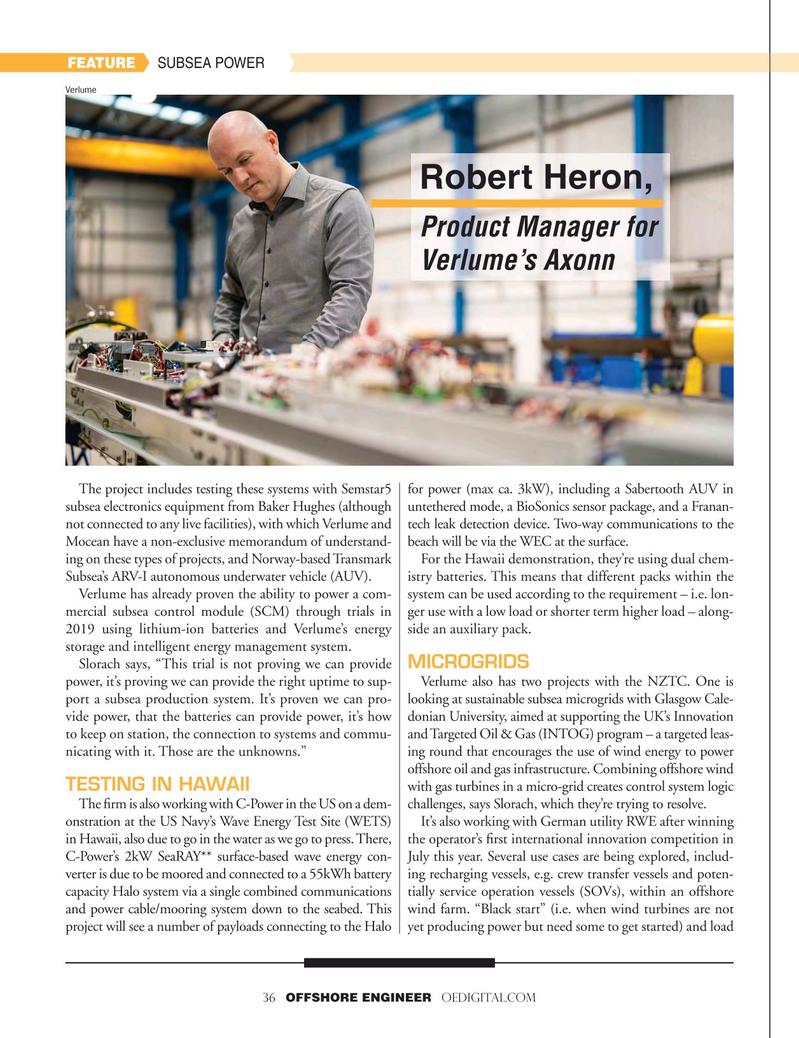
Page 36: of Offshore Engineer Magazine (Nov/Dec 2022)
Read this page in Pdf, Flash or Html5 edition of Nov/Dec 2022 Offshore Engineer Magazine
FEATURE SUBSEA POWER
Verlume
Robert Heron,
Product Manager for
Verlume’s Axonn
The project includes testing these systems with Semstar5 for power (max ca. 3kW), including a Sabertooth AUV in subsea electronics equipment from Baker Hughes (although untethered mode, a BioSonics sensor package, and a Franan- not connected to any live facilities), with which Verlume and tech leak detection device. Two-way communications to the
Mocean have a non-exclusive memorandum of understand- beach will be via the WEC at the surface.
ing on these types of projects, and Norway-based Transmark For the Hawaii demonstration, they’re using dual chem-
Subsea’s ARV-I autonomous underwater vehicle (AUV). istry batteries. This means that different packs within the
Verlume has already proven the ability to power a com- system can be used according to the requirement – i.e. lon- mercial subsea control module (SCM) through trials in ger use with a low load or shorter term higher load – along- 2019 using lithium-ion batteries and Verlume’s energy side an auxiliary pack. storage and intelligent energy management system.
MICROGRIDS
Slorach says, “This trial is not proving we can provide power, it’s proving we can provide the right uptime to sup- Verlume also has two projects with the NZTC. One is port a subsea production system. It’s proven we can pro- looking at sustainable subsea microgrids with Glasgow Cale- vide power, that the batteries can provide power, it’s how donian University, aimed at supporting the UK’s Innovation to keep on station, the connection to systems and commu- and Targeted Oil & Gas (INTOG) program – a targeted leas- nicating with it. Those are the unknowns.” ing round that encourages the use of wind energy to power offshore oil and gas infrastructure. Combining offshore wind with gas turbines in a micro-grid creates control system logic
TESTING IN HAWAII
The ?rm is also working with C-Power in the US on a dem- challenges, says Slorach, which they’re trying to resolve.
onstration at the US Navy’s Wave Energy Test Site (WETS) It’s also working with German utility RWE after winning in Hawaii, also due to go in the water as we go to press. There, the operator’s ?rst international innovation competition in
C-Power’s 2kW SeaRAY** surface-based wave energy con- July this year. Several use cases are being explored, includ- verter is due to be moored and connected to a 55kWh battery ing recharging vessels, e.g. crew transfer vessels and poten- capacity Halo system via a single combined communications tially service operation vessels (SOVs), within an offshore and power cable/mooring system down to the seabed. This wind farm. “Black start” (i.e. when wind turbines are not project will see a number of payloads connecting to the Halo yet producing power but need some to get started) and load 36 OFFSHORE ENGINEER OEDIGITAL.COM

 35
35

 37
37